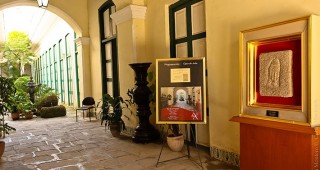Mid-way along the west side of the Basílica Menor y Convento de San Francisco de Asís, Calle Brasil (Teniente Rey) leads south one block to Plaza Vieja. Exposed in the center of the cobbled street are two archaeological sites displaying portions of the Zanja Real (Royal Canal)— the original aqueduct that was initiated in 1566 and supplied the city with water before the construction of the Albear Acqueduct in 1835.

Patronato de la Casa de la Comunidad Hebrea y Gran Sinagoga bet Shalom LH  2
2
This is the biggest of Cuba’s five synagogues and is considered one of the most important architectural works in the country. It has a hard-looking exterior with vertical lines that make reference to …
 ModernI #241, entre 13 y 15
ModernI #241, entre 13 y 15 
Fuente de las Américas LH  2
2
The Fuente de Las Américas, built as a tribute to the discoverer of the Americas, was inaugurated in 1924 as part of the construction of Avenida de las Américas, now known as 5ta Avenida. Made in whit …

Hotel Telégrafo LH  2+
2+
Initially located on Amistad Street and relocated in 1899 to its present site, the Telégrafo Hotel was rebuilt in 1911 and was considered then one of the most modern hotels in Havana. In 2001 it was r …
 $48 - $69ROOMS: 63Prado No. 408 esquina a Neptuno
$48 - $69ROOMS: 63Prado No. 408 esquina a Neptuno 
Casa de Asia LH  2
2
Opened in 1997, this small museum—upstairs in a townhouse mansion built in 1688—displays collections that depict the lifestyle, dress, religious beliefs, rituals and traditions from different Asiatic …

Banco de La Habana LH  2
2
This 1915 two-story building was made of reinforced concrete. Its façade was composed of elements of the Ionic order and stood out because of its semicircular portico and its beautiful wooden door, wh …
 EclecticAdmission: FreeCuba e/ Obispo y Obrapía, Habana Vieja
EclecticAdmission: FreeCuba e/ Obispo y Obrapía, Habana Vieja 
Parque de la Fraternidad LH  2
2
By 1790, this originally mangrove swampy area became Campo de Marte, a military practice range, which was expanded in 1793 thanks to a project by Belgian engineer Agustin Cramer. And after Bishop Espa …

Parque de los Mártires Universitarios LH  2
2
This cement park was built in 1967 to honor university students involved in Cuba’s independence struggles. The most notable element, located by the most important entrance, can be interpreted a fist, …

Cárcel de la Habana LH  2
2
Up until 1834 there were no prisons in Havana. Back then, prisoners were crammed together in a small area on the Palacio de Gobierno’s basement. With this in mind, Lieutenant General Miguel Tacón, Gov …

Museo Farmacia Taquechel LH  2
2
This townhouse was adapted in 1898 into a pharmacy by Francisco Taquechel. Restored and reopened in 1996, it functions as pharmacy and museum. Its collection includes 19th-century French porcelain apo …

Casa del Científico (Casa de José Miguel Gómez) LH  2
2
The compact yet extravagant Beaux Arts building on the northwest corner of Prado and Trocadero was once the residence of Cuba’s second president, José Miguel Gómez, known as ‘El Tiburón’ (The Shark). …
 EclecticAdmission: FreePrado #212 esq. a Trocadero, Habana Vieja
EclecticAdmission: FreePrado #212 esq. a Trocadero, Habana Vieja 



